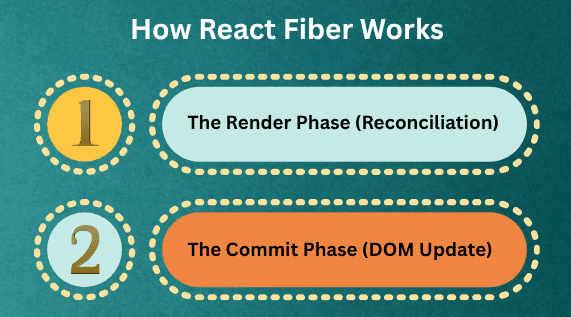React Fiber Architecture – How React Updates the DOM Efficiently
React is known for being fast and efficient, even when handling complex user interfaces. But how does React decide what to update and when?
The answer lies in React Fiber Architecture, a powerful internal engine introduced in React 16 that completely changed how React handles reconciliation and rendering.
What is React Fiber?
React Fiber helps React break down rendering work into smaller chunks and spread it out over multiple frames — making the UI smooth, responsive, and fast.
Before Fiber, React used a stack-based algorithm, which was synchronous and could block the main thread. Fiber introduced asynchronous rendering, allowing React to pause, resume, or cancel work intelligently.
Why React Fiber Was Introduced
Earlier versions of React had one big limitation:
- When React started rendering, it couldn’t stop until it was done.
- If the UI was large or complex, this could cause jank, lag, or even the browser to freeze.
React Fiber was designed to solve this problem by:
- Breaking rendering into small units of work
- Prioritizing important updates (like user input)
- Allowing React to pause and resume work
- Supporting features like Suspense and Concurrent Rendering
How React Fiber Works
- Fiber introduces a new data structure — the Fiber Node.
- Each Fiber Node represents a component (functional or class) in your React app.
- React maintains a tree of Fiber nodes, known as the Fiber Tree.
- Every time something changes (like state or props), React builds a work-in-progress Fiber Tree to compare with the current Fiber Tree.
This process happens in two main phases :

1. The Render Phase (Reconciliation)
In this phase:
- React creates or updates Fiber nodes based on changes.
- It compares the new tree with the previous one (diffing).
- It figures out what needs to change in the real DOM.
This phase is asynchronous — React can pause, resume, or even abandon it if a higher-priority task appears (like a user typing).
2. The Commit Phase (DOM Update)
Once React knows what needs to change:
- It commits the updates to the real DOM.
- This phase is synchronous — once it starts, it finishes quickly.
So, the flow looks like this
Render Phase → Prepare Updates → Commit Phase → DOM Updated
Example: Fiber in Action (Simplified)
When you update state like this:
function Counter() {
const [count, setCount] = React.useState(0);
return (
<button onClick={() => setCount(count + 1)}>
Count: {count}
</button>
);
}
Here’s what happens under the hood:
- You click the button → triggers
setCount() - React schedules a new render work unit
- Fiber starts reconciliation (render phase)
- React compares the new and old Fiber trees
- Changes are committed to the DOM efficiently
Instead of re-rendering everything, React updates only the changed parts — thanks to Fiber.
Fiber = Virtual DOM + Scheduler
Think of Fiber as combining two key ideas:
- Virtual DOM → Efficiently calculates what needs updating
- Scheduler → Decides when and how fast to perform updates
Together, they enable React to deliver Concurrent Rendering, Suspense, and smooth UI performance.
Key Features of React Fiber
| Feature | Description |
|---|---|
| Incremental Rendering | Splits rendering into chunks, avoids blocking UI |
| Scheduling & Prioritization | Urgent updates (like user input) get higher priority |
| Pause & Resume Rendering | React can yield control to the browser when needed |
| Better Error Handling | Improved support for componentDidCatch and error boundaries |
| Foundation for Modern React | Enables Hooks, Suspense, and Concurrent Mode |
Visualization of Fiber Workflow
User Interaction
↓
Trigger State Update
↓
Reconciliation (Render Phase)
↓
Fiber Tree Comparison
↓
Commit Phase (DOM Update)
↓
UI Updated Efficiently
Benefits of React Fiber Architecture
- Smoother performance during heavy renders
- No UI blocking during complex updates
- Fine-grained control over rendering priorities
- Foundation for modern async features
- Improved user experience on slower devices
Fiber and Modern React Features
React Fiber powers many advanced React capabilities:
- Suspense → Works seamlessly with async rendering
- Concurrent Rendering → Smoother UI updates
- Hooks → Efficient re-renders with less overhead
- Error Boundaries → Stable app error recovery

